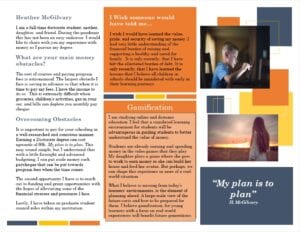Our Essay Question
- As a college/university student, what are your main money obstacles and what do you plan on doing to address these issues?
- Looking back, how should schools have taught money management to children under 18
The Well-Researched Response From A.A.
Schools teach students skills like reading, writing, and math to prepare them for adulthood and to equip them with the abilities they need to live as functional members of society. However, with less than 35% of students feeling confident enough to manage their own finances when they’re finished school [1] and with 8 out of 10 young Canadians not feeling confident in their financial knowledge [1], the way that schools currently teach money management does not prepare children to succeed as adults. With money management being such an integral skill for leading a good life without unnecessary financial burden, schools need to teach children, from as early as possible, how to properly manage money.
Looking for more money for school? Enter our scholarship essay contest!
From as early as kindergarten, schools can teach students the importance of delaying gratification. Delaying gratification means resisting immediate rewards in the hopes of receiving better rewards in the future, and children who are able to delay gratification early tend to perform better in school and to have better emotional coping skills even decades later in life [2]. By introducing “stop and go” games into the classroom [2], which are games like Follow the Leader or Simon Says, in which children learn to monitor their immediate reactions and delay their actions until the appropriate times, schools can help children develop the ability to delay their gratification which will make it easier for them to adopt money management principles like saving and budgeting later on in life.
As students begin to learn to identify different amounts of cash and to understand the value of cash in the first and second grade [3], teachers can introduce token economies into the classroom. With token economies, students “can accumulate fake money or other tokens to spend on rewards like free time or a homework pass” [2] and can learn the value of saving money by saving larger token amounts to get larger rewards. Additionally, token economies also teach students that when they spend money, the money is actually gone, and that to get more money, they need to put in the work to earn more money, which instills in the students the value of spending less than they earn. The skills that students gain from interacting with token economies also prepare them for learning more complex money management principles like budgeting later on.
The lessons of delayed gratification and saving should be revisited regularly as students advance through grade levels, and once students reach a middle school or junior high level, they should be introduced to more concrete lessons around budgeting. In the classroom, with worksheets, games, and other helpful tools, students should be taught how to categorize and differentiate between income and expense items. With income items, students should be taught the difference between reliable income and seasonal or variable income. With expense items, students should be taught how to differentiate between expenses spent on things that are “wants” and expenses spent on things that are “needs”. Students should also be taught to include savings in their budgets and should be taught the skills necessary for them to readjust their budgets when unexpected circumstances arise which provide unexpected income items or expense items.
Once students are equipped with the skills necessary to manage essentially “fixed” money, where a dollar saved now holds the same value in the future, schools can begin to teach students about chequing accounts, savings accounts (in which money can earn interest) and debit cards. At around the eighth or ninth grade where students are around thirteen or fourteen years old, some students will begin to start working jobs and earning money. The practical lessons about money management that schools can teach working students will go a long way in helping them make shrewd financial decisions with their newly earned money. Schools can even set up workshops for working students to educate them about the financial tools they have available to them, like RRSPs. Even for students that are not working, learning about the options available to them when it comes to bank accounts and learning about how to use debit cards properly will set them up for success when they do start to earn money.
In high school, schools can start teaching students about stocks, bonds, and other investment vehicles. Building on the students’ learnings about how interest rates can affect the value of money, schools can teach students about how investing can similarly grow or shrink money. In showing students how money can grow over time with compound interest, schools can educate students on the basics of how inflation affects “fixed” money that does not grow or accrue interest. With virtual stock exchanges [4] where students can trade real stocks with virtual money, teachers can gamify the students’ experience of learning about the stock market and can set competitions where the top student traders of virtual currency can receive a real prize. Using the more hands-on approach of having students interact with virtual exchanges, teachers can reify the more abstract lessons about trading by having students trade real stocks, and they can also pique their students’ interests in wise investments while continually reinforcing the lesson that the delayed gratification of putting one’s money aside in an investment account instead of spending it can yield positive results in the future.
As students enter the eleventh and twelfth grades and start to turn eighteen, schools can educate students about the financial tools they become eligible for once they become eighteen, like credit cards and TFSAs. In teaching students about credit early, schools can help student to build a solid credit history and they can also teach students about the different types of credit cards available to them, so that students can make informed choices as they begin down the path of building their credit. Schools can also help students save money on taxes by teaching them about TFSAs and about when to keep money in a chequing account, a savings account, a TFSA, an RRSP, or elsewhere. In informing students about the financial tools available to them as they enter adulthood, schools empower students to manage their money effectively and to avoid poor financial decisions.
To prepare twelfth grade students for life after high school, schools can teach them about debt, loans, and taxes. By informing students not only about the difference between good debt and bad debt, but also about how to prevent bad debt, schools can help to alleviate the fears that people between the ages of 18 and 24 feel about “never being able to get out of debt” [1]. Teaching students about car loans, mortgages and especially about student loans can help students to make smarter financial choices about the loans they take on. Additionally, the knowledge that students have learned about budgeting can be updated with their new learnings about loans to keep students at the helm of maintaining a healthy relationship between their income and their expenses. To help students with taxes, teachers could go through the process of “filing” a fake tax return with students and could educate them about the what the different parts of a tax return mean. To provide students with additional income opportunities, teachers and schools alike could inform students about open scholarships and job opportunities. Ultimately, by the end of their high school career, schools should provide students with the money management skills they need to make educated financial decisions about their next move in life, whether that be going to college, going to university, or working a job.
Schools have a large role to play in preparing students for adult life and in providing students with the tools they need to navigate life’s difficulties. While schools do equip students with the educational skills that students need to navigate higher education and other situations that require critical thinking skills, they do not adequately teach students the money management skills that students need to evolve into financially responsible adults. By providing students with an early foundation in delaying gratification, and by building on that foundation by teaching students the necessary skills of saving, budgeting and investing as students grow, schools can better equip their students with the financial knowledge they need to make good decisions with their money and to better manage their own finances when they finish school.
[1] http://visionspire.ca/the-shocking-truth-about-financial-literacy-in-canada/
[2] https://kirstenskaboodle.com/delayed-gratification-in-the-classroom/
[3] https://www.parents.com/kids/education/elementary-school/what-your-kid-will-learn-in-first-grade/
[4] https://www.marketwatch.com/game




